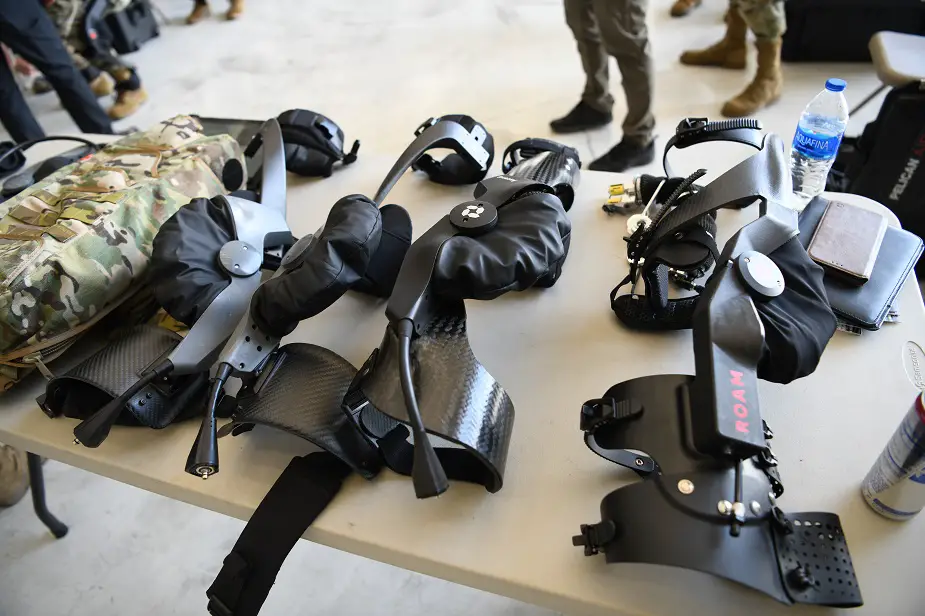Breaking news
US Air Force examines the use of exoskeleton for moving cargo.
The Air Force Research Laboratory’s Center for Rapid Innovation, or CRI, held an event Oct. 6 with the Air Force Reserve Command’s 445th Airlift Wing for a ROAM Robotics team to demonstrate the latest Forge System, a pneumatically-powered exoskeleton that augments leg strength to reduce fatigue, increase endurance and offset weight.
Follow Air Recognition on Google News at this link

Chief Master Sgt. Sean Storms, 445th Airlift Wing aerial port manager, pushes oversized cargo across the floor of a C-17 Globemaster III during an Air Force Research Laboratory demonstration of a pneumatically-powered exoskeleton system at Wright-Patterson Air Force Base, Ohio, Oct. 6, 2022. The exoskeleton was designed to assist aerial porters load and unload heavy cargo and is intended to minimize manpower and prevent injuries (Picture source: USAF)
The event began with a presentation of the pneumatically-powered exoskeleton system, which is supported by Direct to Phase II Small Business Innovation Research project called Radical Improvements in Personnel Performance through Enhanced Development, or RIPPED.
Two aerial porters from the 87th Aerial Port Squadron waited in the back of a C-17 Globemaster III to demonstrate the technology. Aerial porters are responsible for the management and movement of passengers and cargo transported through airlift. The cargo that aerial porter teams load and unload can range from large pallets of equipment, gear and food.
Chief Master Sgt. Sean Storms, 87th APS aerial port manager, and Senior Master Sgt. Brian Anders, 87th APS assistant aerial port manager, donned the technology, which consisted of actuated leg braces and a backpack, and moved a pallet that weighed about 3,500 pounds. The two porters equipped with the Forge System moved the pallet on their own, a weight typically moved by four or five people.
“I can definitely tell a difference; there’s a lot less pressure on my knees and I can feel the assist this system gives,” Storms said.
Following the demo, participants were invited to try out the exoskeleton. Some climbed a set of stairs while carrying weights. Others tested it by pushing a weighted sled. Regardless of the test, participants could hear the exoskeleton’s air bladder actuators engaging as they moved.
 Brig. Gen. John Andrus, 711th Human Performance Wing commander, pushes a weighted sled while wearing the pneumatically-powered exoskeleton during an Air Force Research Laboratory demonstration at Wright-Patterson Air Force Base, Ohio, Oct. 6, 2022 (Picture source: USAF)
Brig. Gen. John Andrus, 711th Human Performance Wing commander, pushes a weighted sled while wearing the pneumatically-powered exoskeleton during an Air Force Research Laboratory demonstration at Wright-Patterson Air Force Base, Ohio, Oct. 6, 2022 (Picture source: USAF)
John Florio, CRI deputy director, explained that this technology could be a game changer for the aerial port community.
“If this is optimized for the aerial porters’ particular missions, it is going to mean that teams will be able to load heavier objects on aircraft much faster using less people, which equates to saving the government and taxpayer money,” he said. “But the biggest game changer for the Air and Space Forces is less injuries to personnel, which can lead to longer careers.”
Florio explained the weight the aerial porters are required to move during missions, sometimes in austere environments or under fire is unlike what some may experience when moving to a new home or office.
“If you’ve ever loaded anything in an office or maybe at home like a refrigerator — anything like that is small compared to what our aerial porters are loading,” Florio said. “For them, we’re talking about large pieces of cargo going into a large aircraft. So knees are under stress; ankles are under stress; backs are under stress; muscles all over the body are under stress. I've talked to a lot of the people here in the maintenance squadron, and chronic injuries are rampant all over this particular career field and in other related fields too.”
The related fields Florio mentioned were on the mind of Brig. Gen. John Andrus, 711th Human Performance Wing commander, who also attended the demonstration.
“I can see additional uses for this pneumatically-powered exoskeleton, primarily in aeromedical evacuation missions where our medical personnel are lifting large litters of sick and injured warfighters into the back of aircraft,” Andrus said. “We have to think about the safety of our medical personnel, but also the safety of those we are treating and evacuating out of harm’s way.”
Participants asked about other potential career fields that might benefit from the assisted technology. Tim Swift, ROAM Robotics CEO, stated the system could be adapted to fit other missions, but for now, attention was on providing relief to the aerial porter community, which he said sees an estimated $31 million in annual disability benefits and suffers from lost workday injuries.
“The opportunity to have something like this exoskeleton, that provides a capability that augments the aerial porter’s strength, that takes pressure off joints, that makes their muscles work more efficiently, and in the long run, that prevents overuse injuries – well, it's going to be a game changer,” Florio said.

The pneumatically-powered exoskeleton, developed by ROAM Robotics as part of a Direct to Phase II Small Business Innovation Research grant, is displayed during an Air Force Research Laboratory demonstration at Wright-Patterson Air Force Base, Ohio, Oct. 6, 2022 (Picture source: USAF)

























